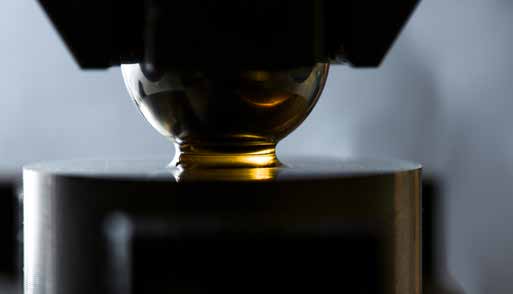
Although lubricants provide for a smooth running of almost all machines, there have not been any fundamental innovations in this field over the past two decades. Together with a consortium, Fraunhofer IWM has now developed a completely new class of substances that could lead to a breakthrough: liquid crystal-based lubricants. They are liquid but also show the same anisotropic physical characteristics as crystals.
Liquid crystals are primarily known for their application in LCD TV screens of televisions, cell phones or touch screens. Nematel GmbH had the unconventional idea of using them as lubricants and approached Fraunhofer IWM with this concept. Tribology experts tested the mostly organic, rod-shaped molecules there with surprising success: When two metallic friction partners move against each other with a liquid-based layer of lubricant between them, the molecule rods align themselves parallel to each other in stable layers. This reduces friction and wear to a minimum and enables an almost smooth sliding.
The background: When a liquid crystalline substance is sheared into friction contact between two surfaces, the molecules are spontaneously aligned so that the shearing movement counters the lowest resistance – the viscosity becomes minimal in the friction direction. The viscosity coefficients vertical to the friction direction are inevitably much larger. Even this condition is useful because the surfaces sliding against each other are better separated from each other, resulting in less wear.
Fraunhofer IWM determined that liquid crystals containing rod-shaped molecules are suitable as lubricants. However, a lot more work was needed to make a practicable lubricant out of the liquid crystals. Together with Nematel GmbH and lubricant expert Dr. Tillwich GmbH, Fraunhofer IWM started a project that was funded by the Federal Ministry of Education and Research. The lubricant developers at Tillwich improved the stability of the fluid crystal lubricants with the aid of additives. They also built a test stand with which they could carry out contactless measurements of the extremely low friction values with laser technology.
Fraunhofer IWM decoded the material-mechanical mechanisms that lead to the ultra low friction values with tests and simulations and specifically found out how the new lubricants could be further improved. In addition, the scientists examined the chemical mechanisms in frictional contact and the effect of mixing different liquid crystal molecules.
At the end of the project, the partners had the prototype of a liquid crystal lubricant that showed its best effect on bearings made of iron. In 2014, the consortium received the science award of the Stifterverband for their pioneering achievement. This award is presented every two years for excellent collaborative projects in applied research.
Together with further partners in the industry, the next steps will be to develop innovative bearings lubricated with liquid crystals for small electronic motors in cars, such as those used in generators or to power windshield wipers. Because of the (still) expensive synthesis compared to standard lubricants, suitable areas of application are those in which only small quantities of lubricants are required.
 Fraunhofer Group for Materials and Components - Materials
Fraunhofer Group for Materials and Components - Materials